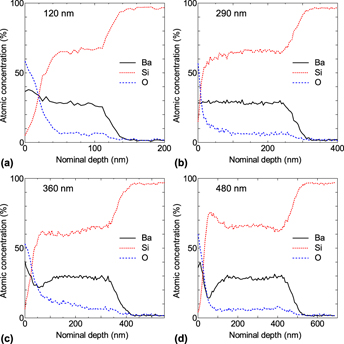Crossref Citations
This article has been cited by the following publications. This list is generated based on data provided by
Crossref.
Hara, Kosuke O.
Arimoto, Keisuke
Yamanaka, Junji
and
Nakagawa, Kiyokazu
2019.
Fabrication of SnS/BaSi2 heterojunction by thermal evaporation for solar cell applications.
Japanese Journal of Applied Physics,
Vol. 58,
Issue. SB,
p.
SBBF01.
Hara, Kosuke O.
Arimoto, Keisuke
Yamanaka, Junji
and
Nakagawa, Kiyokazu
2020.
Interface reaction of the SnS/BaSi2 heterojunction fabricated for solar cell applications.
Thin Solid Films,
Vol. 706,
Issue. ,
p.
138064.
Tian, Yilei
Zeman, Miro
and
Isabella, Olindo
2020.
Face-to-face annealed sputtered
BaSi2
: Investigations on surface homogeneity, film properties, and annealing mechanisms.
Physical Review Materials,
Vol. 4,
Issue. 12,
Yoshino, Takamasa
Nakagawa, Yoshihiko
Kimura, Yuki
Fujiwara, Michinobu
Kurokawa, Yasuyoshi
and
Usami, Noritaka
2020.
Influence of the time-dependent vapor composition on structural properties of the BaSi2 thin films fabricated by vacuum evaporation.
Japanese Journal of Applied Physics,
Vol. 59,
Issue. SF,
p.
SFFA10.
Hara, Kosuke O.
Takizawa, Shuhei
Yamanaka, Junji
Usami, Noritaka
and
Arimoto, Keisuke
2020.
Reactive deposition growth of highly (001)-oriented BaSi2 films by close-spaced evaporation.
Materials Science in Semiconductor Processing,
Vol. 113,
Issue. ,
p.
105044.
Yazawa, Daisuke
Hara, Kosuke O.
Yamanaka, Junji
and
Arimoto, Keisuke
2021.
Investigations on Ba diffusion and SiO evaporation during BaSi2 film formation on Si substrates by thermal evaporation.
Journal of Vacuum Science & Technology A: Vacuum, Surfaces, and Films,
Vol. 39,
Issue. 4,
Aonuki, Sho
Yamashita, Yudai
Toko, Kaoru
and
Suemasu, Takashi
2021.
Effects of Ba-to-Si deposition rate ratios on the electrical and photoresponse properties of arsenic-doped n-type BaSi2 films.
Thin Solid Films,
Vol. 738,
Issue. ,
p.
138969.
Nakagawa, Yoshihiko
Takahashi, Kazuma
Fujiwara, Michinobu
Hara, Kosuke O.
Gotoh, Kazuhiro
Kurokawa, Yasuyoshi
Itoh, Takashi
Suemasu, Takashi
and
Usami, Noritaka
2021.
Fabrication of heterojunction crystalline Si solar cells with BaSi2 thin films prepared by a two-step evaporation method.
Japanese Journal of Applied Physics,
Vol. 60,
Issue. 10,
p.
105503.
Hara, Kosuke O.
Yamamoto, Chiaya
Yamanaka, Junji
and
Arimoto, Keisuke
2021.
Low temperature synthesis of photoconductive BaSi2filmsviamechanochemically assisted close-spaced evaporation.
Materials Advances,
Vol. 2,
Issue. 20,
p.
6713.
Suemasu, T.
Hara, K. O.
Udono, H.
and
Imai, M.
2022.
Silicon meets group-II metals in energy and electronic applications—How to handle reactive sources for high-quality films and bulk crystals.
Journal of Applied Physics,
Vol. 131,
Issue. 19,
Kurokawa, Yasuyoshi
Yoshino, Takamasa
Gotoh, Kazuhiro
Miyamoto, Satoru
and
Usami, Noritaka
2022.
Fabrication of BaSi2 homojunction diodes on Nb-doped TiO2 coated glass substrates by aluminum-induced crystallization and two-step evaporation method.
Japanese Journal of Applied Physics,
Vol. 61,
Issue. SC,
p.
SC1029.
Fujiwara, Michinobu
Takahashi, Kazuma
Nakagawa, Yoshihiko
Gotoh, Kazuhiro
Itoh, Takashi
Kurokawa, Yasuyoshi
and
Usami, Noritaka
2022.
Improved conversion efficiency of p-type BaSi2/n-type crystalline Si heterojunction solar cells by a low growth rate deposition of BaSi2.
AIP Advances,
Vol. 12,
Issue. 4,
HARA, Kosuke O.
YAMANAKA, Junji
and
ARIMOTO, Keisuke
2023.
Development of Close-Spaced Evaporation Technique for BaSi<sub>2</sub> Films toward Solar Cell Applications.
Vacuum and Surface Science,
Vol. 66,
Issue. 7,
p.
388.
Ueda, Ryuto
Arimoto, Keisuke
Yamanaka, Junji
and
Hara, Kosuke O.
2023.
Constructing the composition ratio prediction model using machine learning for BaSi2 thin films deposited by thermal evaporation.
Japanese Journal of Applied Physics,
Vol. 62,
Issue. SK,
p.
SK1011.
Mohmad, Abdul Rahman
Abdullah, Huda
Kido, Kazuki
Hasebe, Hayato
Du, Rui
Mesuda, Masami
and
Suemasu, Takashi
2024.
Investigation of defects in BaSi2 thin film on Si prepared by co-sputtering technique.
Journal of Luminescence,
Vol. 275,
Issue. ,
p.
120797.
Hara, Kosuke O.
Nakanishi, Takaharu
Ueda, Ryuto
Yamanaka, Junji
and
Arimoto, Keisuke
2025.
Inert interlayers and evaporation techniques for high-quality BaSi2 heterostructures.
Japanese Journal of Applied Physics,
Vol. 64,
Issue. 2,
p.
02SP31.



